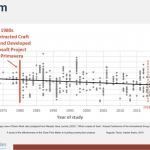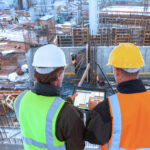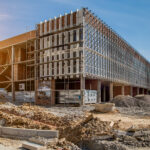Prefabrication and off-site construction are not novel concepts, but it has yet to be mainstream for commercial construction. More sophisticated MEP trades and some wall panel companies are pulling the industry in that direction.
I recently talked with a superintendent who had seven weeks in his schedule for exterior framing and sheathing on a 50,000 SF green field church project. By switching to pre-fab, the total on-site time was three weeks. He also cited the gains in safety due to less manpower required and removing the requirement for workers to hoist individual sheets from boom lifts. When you think about it, most of the time, doing sheathing on-site is a waste. The predominant activity is moving the lift to position material instead of fastening it to the studs.
Aside from the obvious time savings on the jobsite, there are higher-level and more strategic benefits to building off-site. You guessed it; it has to do with the supply chain, and most of it deals with eliminating waste.
Why is this? Reference back to the intro to this series. There is a trade-off between efficiency and responsiveness. Efficient supply chains have less waste but are less resilient. Remember the toilet paper crisis? Efficient, but not so resilient to a shock in demand. Construction supply chains have typically been responsive at the expense of efficiency due to the dynamic nature of projects. The trade-off requires the supply chain to allow for waste in the form of inventory.
Describing the Baseline Construction Supply Chain without pre-fabrication
The standard construction supply chain is a conglomeration of fragmented sub-supply chains that converge to the place where value is added. The unique bit about construction is that the final location where value is added is also the end product’s final destination. The jobsite is the construction factory, and no two are alike. Creating steady flow [efficiency] in such a system is nearly impossible.
From the superintendent’s vignette above, he mentioned the almost just-in-time nature of his experience with pre-fab resulted in a cleaner site and less inventory waste. Sure, the factory where the panels are made may have to maintain some inventory; however, due to reduced cycle time to build in the factory and installation on the jobsite, raw materials have less net storage time in the supply chain. In this case, up to four weeks less as the material would have sat on the jobsite until it was ready to be installed.
Every stakeholder in the value chain should care about this because it ties directly to the project’s bottom line.
Owners, if you walk out to your project and see stacks and stacks of inventory sitting on-site, you are paying for it. Regardless of the purchase price your project team was able to secure, there are secondary and tertiary costs associated with storing material.
What prefabrication will help us do in the future
Prefabrication is essential to building more certainly by eliminating waste associated with traditional construction. Additionally, the benefits of safety and quality cannot be ignored. One lesson from the pre-fab wall panel example above is that the superintendent knows he would have saved more time had he coordinated early enough to add waterproofing scope in the factory. Doing so would have allowed for more certain quality control, reduced time having workers in lifts, and more savings to the schedule.
How prefabrication plus integrated technology makes project delivery more certain
Prefabrication alone is great, but it’s only one component of industrialized construction. The next step is to couple prefabrication with technology, data, and analytics. One platform that I am excited to see is Katalyst.di. [[email protected]] Their position that predictable supply chains generate predictable construction projects is spot on, and the way they are going about it is exactly right. Enabling collaboration across supply chain stakeholders by integrating data and workflows is much needed in the AECO space. Using a planning platform like Touchplan to forecast demand coupled with a supply chain platform like Katalyst.di is how projects will be delivered with more certainty in the future.










